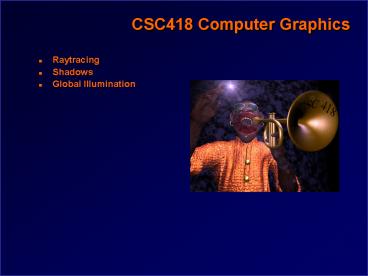CSC418 Computer Graphics - PowerPoint PPT Presentation
1 / 51
Title:
CSC418 Computer Graphics
Description:
... or radiosity (both are incomplete) Try to measure light propagation in the scene ... 'shower' scene with light and then collect it 'Where does light go? ... – PowerPoint PPT presentation
Number of Views:29
Avg rating:3.0/5.0
Title: CSC418 Computer Graphics
1
CSC418 Computer Graphics
- Raytracing
- Shadows
- Global Illumination
2
Local vs. Global Illumination
- Local Illumination Models
- e.g. Phong
- Model source from a light reflected once off a
surface towards the eye - Indirect light is included with an ad hoc
ambient term which is normally constant across
the scene - Global Illumination Models
- e.g. ray tracing or radiosity (both are
incomplete) - Try to measure light propagation in the scene
- Model interaction between objects and other
objects and objects and their environment
3
All surfaces are not created equal
- Specular surfaces
- e.g. mirrors, glass balls
- An idealized model provides perfect reflection
- Incident ray is reflected back as a ray in a
single direction - No scattering (unrealistic)
- Diffuse surfaces
- e.g. flat paint, chalk
- Lambertian surfaces
- Incident light is scattered in all directions
- Also unrealistic for most surfaces
4
Categories of light transport
- Specular-Specular
- Specular-Diffuse
- Diffuse-Diffuse
- Diffuse-Specular
5
Real surfaces are more complex
6
Ray Tracing
- Traces path of specularly reflected or
transmitted (refracted) rays through environment - Rays are infinitely thin
- Dont disperse
- Signature shiny objects exhibiting sharp,
multiple reflections
7
Ray Tracing
- Unifies in one framework
- Hidden surface removal
- Shadow computation
- Reflection of light
- Refraction of light
- Global specular interaction
8
Raytracing slides borrowed from
9
(No Transcript)
10
Ray tracing setup
11
(No Transcript)
12
Ray does not intersect objects
13
(No Transcript)
14
(No Transcript)
15
(No Transcript)
16
Ray hits object
17
(No Transcript)
18
Shadow test
19
(No Transcript)
20
Point in shadow
- With a simple lighting model, apply the ambient
term for the shadow region
21
(No Transcript)
22
(No Transcript)
23
Reflected ray is sent out from intersection point
24
Reflected ray has hit object
- Local illumination model calculated where ray
intersects with second object - Result carried back to origin of ray on first
object, contributes to objects colour
25
(No Transcript)
26
Transmitted ray generated for transparent objects
27
Transmitted ray hit object
- Local illumination model calculated where the ray
hit object - Result carried back to the point of first
intersection
28
(No Transcript)
29
No reflection
30
Single reflection
31
Double reflection
32
Ray Tracing Deficiencies
- Local specular illumination model spreads rays in
specular reflection, but global model doesnt - Ignores major light transport mechanisms
- Interaction of diffuse surfaces
- Intersection computation time is very long
33
Ray Tracing Efficiency Improvements
- Bounding volumes
- Spatial subdivision
- Octrees
- SEADS
- BSP
34
Ray Tracing Improvements Image Quality
- Backwards ray tracing
- Trace from the light to the surfaces and then
from the eye to the surfaces - shower scene with light and then collect it
- Where does light go? vs Where does light come
from? - Good for caustics
35
Ray Tracing Improvements Image Quality
- Cone tracing
- Models some dispersion effects
- Distributed Ray Tracing
- Super sample each ray
- Blurred reflections, refractions
- Soft shadows
- Depth of field
- Motion blur
36
Radiosity
- Diffuse interaction within a closed environment
- Theoretically sound
- View independent
- No specular interactions
37
Global Illumination
38
Direct light is only part of the story
39
Ambient light
40
Lambertian Reflection and Colour Bleeding
41
Radiosity
42
Radiosity Equation
43
Form Factors
44
Techniques for Calculating Form Factors
45
Techniques for Calculating Form Factors
46
(No Transcript)
47
(No Transcript)
48
(No Transcript)
49
(No Transcript)
50
(No Transcript)
51
Where to next?
- The general rendering equation (not part of this
course!) - Next classCurves and Surfaces































